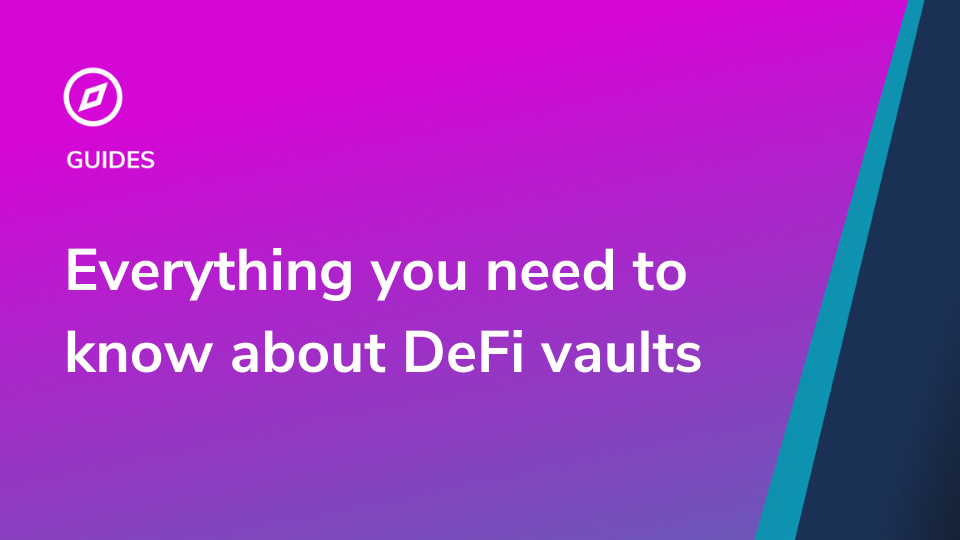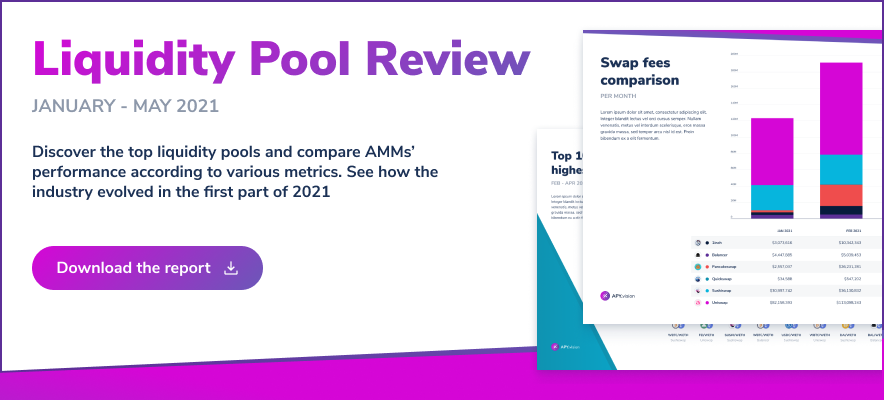Everything You Need to Know About DeFi Vaults

In this post, we’re explaining how DeFi vaults work and also provide a high-level comparison of the main vaults used in DeFi. From this post, you will learn how yield aggregators use vaults to help users optimize their yield farming returns.
What is a Vault in DeFi?
In the DeFi space, there are many projects that issue rewards to users for interacting with their platforms, one example is “staking” tokens on a platform which in turn can increase the total locked value for that project. Typically LP (Liquidity Pool) tokens are used for this purpose as many projects issue rewards in return for users providing the liquidity needed to make the platform run. This is commonly referred to as “yield farming”.
Yield farming for an individual with limited funds can be cost prohibitive due to high transaction costs for claiming rewards. To solve this problem, “yield aggregators” are sets of contracts that pool these staked funds together and allow users to optimize their yield farming by allowing “vaults” to automatically harvest their farming rewards and reinvest them in the liquidity pools, resulting in compounded gains. These auto-compounding vaults can make it so users with smaller portfolios can take advantage of yield farms by depositing into “vaults”, which is the term for the auto-compounding contracts. These vaults allow depositors to not have to worry about gas fees which maximize the returns they can earn on various yield farms.
Vaults can range in complexity and risk, with some using single asset deposits instead of liquidity pool tokens. Some vaults can even utilize more complex strategies that involve multiple protocols and transaction types. It is always wise to research the exact process a vault is using before depositing any funds into one.
Types of DeFi Vaults
Vaults can come in a few different varieties, it is important to be aware that some vaults have greater risks than others!
- Lower risk – Simple strategy – single asset staking vaults (ie deposit DAI and earn more DAI)
- Middle risk – Simple strategy – LP token with auto compounding of the farming rewards
- Highest risk – Advanced strategy – Multi-layered strategies that use multiple farms and protocols (Yearn has many of these)
Example of an Advanced Vault Strategy
Strategy – AaveLenderLINKBorrowerSUSD
“Lends LINK on AAVE to gain interest and accumulate staked AAVE as rewards. Also borrows sUSD which it then deposits into the sUSD yVault for yield. Rewards from vested AAVE and yvSUSD are harvested, sold for more LINK, and re-deposited into the vault.”

How do Vaults Work in DeFi?
Risks of Using DeFi Vaults
There are hundreds of different types of vaults using different strategies with different risk profiles. Typically, single asset vaults have a lower risk of impermanent loss than vaults that require liquidity pool tokens as a deposit asset. That being said, single asset vaults are still subject to price swings based on the value of the token that was deposited into the vault.
Another risk to consider is the smart contract risk, as vaults typically use multiple protocols in their more advanced strategies. Everytime a new protocol is included in a strategy it introduces another layer of risk for hacks or bugs. As an example, there are vaults that can use 3-4 different protocols, and if there is an issue with any of them it can affect the entire vault.
DeFi Vaults Fee Comparison
Here is a comparison of the fees charged by some of the major vault projects. You will typically see fees charged for deposit and withdrawal, as well as a percentage taken out of rewards farmed by the vault.
List of DeFi Vaults Supported by APY.Vision
Yearn
Yearn is the first yield aggregator that offered automated yield farming for users. The protocol is fully decentralized, but has often been led by rockstar coder Andre Cronje. Known for being innovative, changes and upgrades to the protocol are decided with governance votes by YFI token holders. One of their more popular products is yVaults which “are like savings accounts for your crypto assets. They accept your deposit, then route it through strategies which seek out the highest yield available in DeFi.” Yearn currently operates on ETH mainnet and has not expanded to side chains or layer 2’s at this point in time.
Fees
Pickle
Pickle Finance works in a similar way to Yearn, with “Pickle Jars” that offer automated yield strategies much in the same way that vaults work. The Pickle application is available on ETH mainnet and Polygon. Pickle Finance offers Pickle Jars for several different underlying protocols from around DeFi and only works with projects they think will have longevity. The most common protocols that Pickle helps users compound the rewards for are liquidity pools that are on Curve, Uniswap, Sushiswap. Pickle is governed by the PICKLE token that is issued as a reward in various places on the protocol.
Fees
Harvest
Harvest Finance is another vault protocol that is available on ETH mainnet, Binance Smart Chain, and Polygon. The FARM token was launched without any premining, venture capitalist, or investor funds, with 0 circulating supply at launch.
Fees
– Harvest charges a performance fee (currently 30% ETH and 8% BSC)
Beefy
Beefy is a multi-chain yield optimizer operating on Binance Smart Chain, AVAX, Fantom, Polygon, and HECO. Beefy consists of an anonymous team constantly exploring new methods of optimizing automation to secure the largest yields possible. The protocol uses the BIFI token to distribute revenue earned by the protocol as well as for governance decisions.
Fees
With Beefy vaults, performance fees are included in the APY that is listed on the site. Most vaults are available on Beefy.finance hold 4.5% of harvest rewards. This performance fee is largely distributed back to $BIFI stakers and is the main source of revenue for the platform.
Adamant
Adamant is a yield optimizer platform that focuses on the Polygon network. They issue the ADDY token as a reward and also use it for governance purposes. Adamant currently has over 150 vaults for Quickswap, Sushiswap, and other platforms on the Polygon network.
Fees
There is a 30% performance fee taken from the profit each vault generates, but for every 1 ETH in fees collected, 380 ADDY is minted. Some vaults may have reward multipliers that change that number.
There is also a withdrawal fee of 0.5% of your total stake for early withdrawals within 72 hours for all vaults except for the main ADDY-ETH pool.
Eleven
Eleven Finance is a multi-chain yield optimizer operating on Binance Smart Chain, Polygon, Avalanche and OKexChain. They issue the ELE token as rewards and use it for governance.
Fees
Kogefarm
Kogefarm is an auto-compounding utility that operates on the Polygon chain and targets high APR farms. What makes Kogefarm different from many other vault projects are their low fees.
Fees
Polycat
Launched in May 2021, Polycat Finance was one of the first yield farms on the Polygon network. Polycat vaults auto-compound once a minute thanks to the low transaction fees on Polygon and charge no deposit fee, but do charge a withdrawal fee. Polycat has both yield optimization and yield farming aspects to their application.
Fees
Tracking Your Vault with APY.Vision
Given that vaults have thousands of transactions due to auto-compounding, manual tracking of profits or losses can be very time-consuming. APY.Vision can take care of the hard work for you and give you a readout of the performance for the underlying LP tokens as well the additional profit from using any of the vaults we support.
Here is how to track your vault’s performance:
When you load a wallet with one of the supported vaults, you will see the above interface displaying information about your vault position. You can observe the token balance change as well as see the auto-compounding gains that the vault is performing. If you click on “View details” and click on the “Vault Gains” tab, it will bring you to a screen with more context about your position.
This screen shows “Token gain from vault” which shows the change in the token balance due to the shifting prices within the liquidity pool.
This screen shows how many LP tokens you have gained due to being in the vault.
This screen allows you to see which transactions are going into the calculations.
Now you have the information necessary to start using one of the many vault protocols that are available in DeFi to optimize your yield farming! Happy Farming!
APY.Vision does not give investment advice and always insists that you do your own research. Read our full Legal Disclaimer.
Check out APY.Vision!
APY.Vision is an advanced analytics tool for liquidity pool providers and yield farmers. If you’re using any DEXs, AMMs, or liquidity pools this is the tool you will need to easily track the ROI of your liquidity provider and yield farming activities. Try it now!
